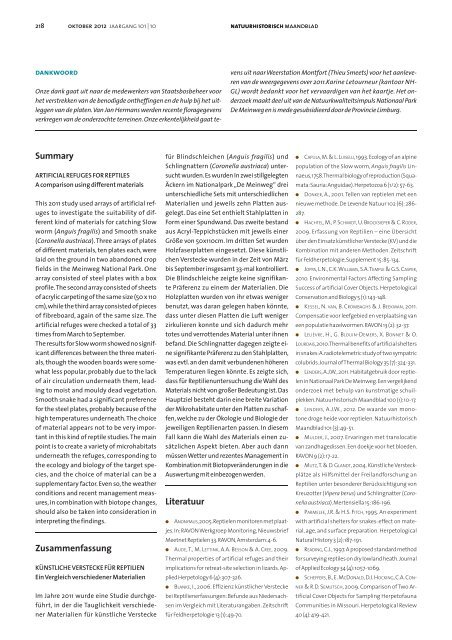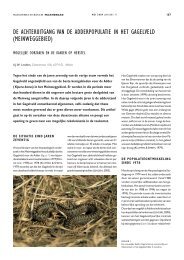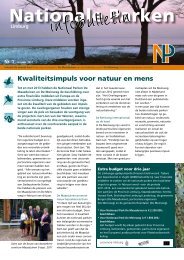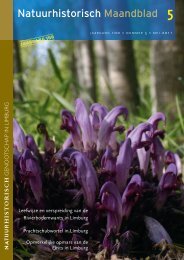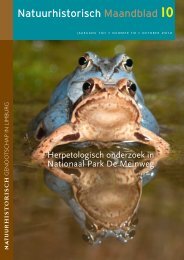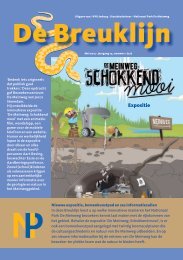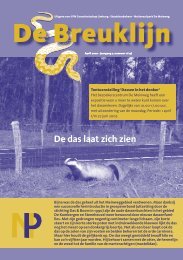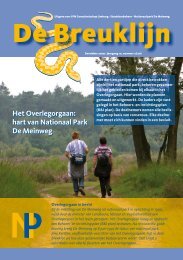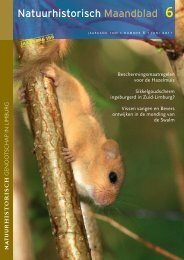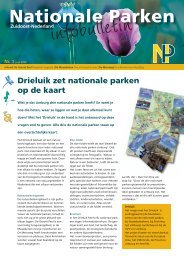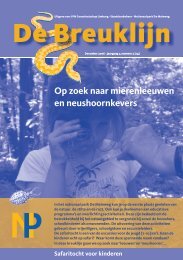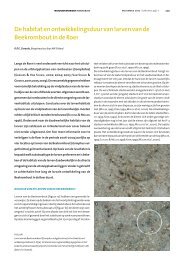Kunstmatige schuilplekken voor reptielen - Nationaal Park De ...
Kunstmatige schuilplekken voor reptielen - Nationaal Park De ...
Kunstmatige schuilplekken voor reptielen - Nationaal Park De ...
Create successful ePaper yourself
Turn your PDF publications into a flip-book with our unique Google optimized e-Paper software.
218 oktober 2012 jaargang 101 | 10 natuurhistorisch maandblad<br />
dankwoord<br />
Onze dank gaat uit naar de medewerkers van Staatsbosbeheer <strong>voor</strong><br />
het verstrekken van de benodigde ontheffingen en de hulp bij het uitleggen<br />
van de platen. Van Jan Hermans werden recente floragegevens<br />
verkregen van de onderzochte terreinen. Onze erkentelijkheid gaat te-<br />
Summary<br />
ArtifiCiAl refuGeS for rePtileS<br />
A comparison using different materials<br />
This 2011 study used arrays of artificial refuges<br />
to investigate the suitability of different<br />
kind of materials for catching Slow<br />
worm (Anguis fragilis) and Smooth snake<br />
(Coronella austriaca). Three arrays of plates<br />
of different materials, ten plates each, were<br />
laid on the ground in two abandoned crop<br />
fields in the Meinweg National <strong>Park</strong>. One<br />
array consisted of steel plates with a box<br />
profile. The second array consisted of sheets<br />
of acrylic carpeting of the same size (50 x 110<br />
cm), while the third array consisted of pieces<br />
of fibreboard, again of the same size. The<br />
artificial refuges were checked a total of 33<br />
times from March to September.<br />
The results for Slow worm showed no significant<br />
differences between the three materials,<br />
though the wooden boards were somewhat<br />
less popular, probably due to the lack<br />
of air circulation underneath them, leading<br />
to moist and mouldy dead vegetation.<br />
Smooth snake had a significant preference<br />
for the steel plates, probably because of the<br />
high temperatures underneath. The choice<br />
of material appears not to be very important<br />
in this kind of reptile studies. The main<br />
point is to create a variety of microhabitats<br />
underneath the refuges, corresponding to<br />
the ecology and biology of the target species,<br />
and the choice of material can be a<br />
supplementary factor. Even so, the weather<br />
conditions and recent management measures,<br />
in combination with biotope changes,<br />
should also be taken into consideration in<br />
interpreting the findings.<br />
Zusammenfassung<br />
kÜNStliCheverSteCke fÜr rePtilieN<br />
einvergleich verschiedener Materialien<br />
Im Jahre 2011 wurde eine Studie durchgeführt,<br />
in der die Tauglichkeit verschiedener<br />
Materialien für künstliche Verstecke<br />
für Blindschleichen (Anguis fragilis) und<br />
Schlingnattern (Coronella austriaca) untersucht<br />
wurden. Es wurden In zwei stillgelegten<br />
Äckern im Nationalpark „<strong>De</strong> Meinweg“ drei<br />
unterschiedliche Sets mit unterschiedlichen<br />
Materialien und jeweils zehn Platten ausgelegt.<br />
Das eine Set enthielt Stahlplatten in<br />
Form einer Spundwand. Das zweite bestand<br />
aus Acryl-Teppichstücken mit jeweils einer<br />
Größe von 50x110cm. Im dritten Set wurden<br />
Holzfaserplatten eingesetzt. Diese künstlichen<br />
Verstecke wurden in der Zeit von März<br />
bis September insgesamt 33-mal kontrolliert.<br />
Die Blindschleiche zeigte keine signifikante<br />
Präferenz zu einem der Materialien. Die<br />
Holzplatten wurden von ihr etwas weniger<br />
benutzt, was daran gelegen haben könnte,<br />
dass unter diesen Platten die Luft weniger<br />
zirkulieren konnte und sich dadurch mehr<br />
totes und verrottendes Material unter ihnen<br />
befand. Die Schlingnatter dagegen zeigte eine<br />
signifikante Präferenz zu den Stahlplatten,<br />
was evtl. an den damit verbundenen höheren<br />
Temperaturen liegen könnte. Es zeigte sich,<br />
dass für Reptilienuntersuchung die Wahl des<br />
Materials nicht von großer Bedeutung ist. Das<br />
Hauptziel besteht darin eine breite Variation<br />
der Mikrohabitate unter den Platten zu schaffen,<br />
welche zu der Ökologie und Biologie der<br />
jeweiligen Reptilienarten passen. In diesem<br />
Fall kann die Wahl des Materials einen zusätzlichen<br />
Aspekt bieten. Aber auch dann<br />
müssen Wetter und rezentes Management in<br />
Kombination mit Biotopveränderungen in die<br />
Auswertung mit einbezogen werden.<br />
Literatuur<br />
l anonymuS, 2005. Reptielen monitoren met plaatjes.<br />
In: RAVON Werkgroep Monitoring, Nieuwsbrief<br />
Meetnet Reptielen 33. RAVON, Amsterdam: 4-6.<br />
l audE, t., m. lEttink, a.a. BESSon & a. crEE, 2009.<br />
Thermal properties of artificial refuges and their<br />
implications for retreat-site selection in lizards. Applied<br />
Herpetology 6 (4): 307-326.<br />
l BlankE, i., 2006. Effizienz künstlicher Verstecke<br />
bei Reptilienerfassungen: Befunde aus Niedersachsen<br />
im Vergleich mit Literaturangaben. Zeitschrift<br />
für Feldherpetologie 13 (1): 49-70.<br />
vens uit naar Weerstation Montfort (Thieu Smeets) <strong>voor</strong> het aanleveren<br />
van de weergegevens over 2011.Karine Letourneur (kantoor NH-<br />
GL) wordt bedankt <strong>voor</strong> het vervaardigen van het kaartje. Het onderzoek<br />
maakt deel uit van de Natuurkwaliteitsimpuls <strong>Nationaal</strong> <strong>Park</strong><br />
<strong>De</strong> Meinweg en is mede gesubsidieerd door de Provincie Limburg.<br />
l capula, m. & l. luiSElli, 1993. Ecology of an alpine<br />
population of the Slow worm, Anguis fragilis Linnaeus,<br />
1758. Thermal biology of reproduction (Squamata:<br />
Sauria: Anguidae). Herpetozoa 6 (1/2): 57-63.<br />
l donkEr, a., 2001. Tellen van <strong>reptielen</strong> met een<br />
nieuwe methode. <strong>De</strong> Levende Natuur 102 (6): 286-<br />
287.<br />
l HacHtEl, m., p. ScHmidt, u. BrockSiEpEr & c. rodEr,<br />
2009. Erfassung von Reptilien – eine Übersicht<br />
über den Einsatz künstlicher Verstecke (KV) und die<br />
Kombination mit anderen Methoden. Zeitschrift<br />
für Feldherpetologie, Supplement 15: 85-134.<br />
l Joppa, l.n., c.k. williamS, S.a. tEmplE & G.S. caSpEr,<br />
2010. Environmental Factors Affecting Sampling<br />
Success of artificial Cover Objects. Herpetological<br />
Conservation and Biology 5 (1): 143-148.<br />
l kESSEl, n. van, B. cromBaGHS & J. BEEkman, 2011.<br />
Compensatie <strong>voor</strong> leefgebied en verplaatsing van<br />
een populatie hazelwormen. RAVON 13 (2): 32-37.<br />
l lEliÈvrE, H., G. Blouin-dEmErS, X. BonnEt & o.<br />
lourdaiS, 2010. Thermal benefits of artificial shelters<br />
in snakes: A. radiotelemetric study of two sympatric<br />
colubrids. Journal of Thermal Biology 35 (7): 324-331.<br />
l lEndErS, a.J.w., 2011. Habitatgebruik door <strong>reptielen</strong><br />
in <strong>Nationaal</strong> <strong>Park</strong> <strong>De</strong> Meinweg. Een vergelijkend<br />
onderzoek met behulp van kunstmatige <strong>schuilplekken</strong>.<br />
Natuurhistorisch Maandblad 100 (1): 10-17.<br />
l lEndErS, a.J.w., 2012. <strong>De</strong> waarde van monotone<br />
droge heide <strong>voor</strong> <strong>reptielen</strong>. Natuurhistorisch<br />
Maandblad 101 (3): 49-51.<br />
l muldEr, J., 2007. Ervaringen met translocatie<br />
van zandhagedissen. Een doekje <strong>voor</strong> het bloeden.<br />
RAVON 9 (2): 17-22.<br />
l mutZ, t. & d. Glandt, 2004. Künstliche Versteckplätze<br />
als Hilfsmittel der Freilandforschung an<br />
Reptilien unter besonderer Berücksichtigung von<br />
Kreuz otter (Vipera berus) und Schlingnatter (Coronella<br />
austriaca). Mertensiella 15: 186-196.<br />
l parmElEE, J.r. & H.S. FitcH, 1995. An experiment<br />
with artificial shelters for snakes: effect on material,<br />
age, and surface preparation. Herpetological<br />
Natural History 3 (2): 187-191.<br />
l rEadinG, c.J., 1997. A proposed standard method<br />
for surveying reptiles on dry lowland heath. Journal<br />
of Applied Ecology 34 (4): 1057-1069.<br />
l ScHEFFErS, B., E. mcdonald, d.J. HockinG, c.a. connEr<br />
& r.d. SEmlitScH, 2009. Comparison of Two Artificial<br />
Cover Objects for Sampling Herpetofauna<br />
Communities in Missouri. Herpetological Review<br />
40 (4): 419-421.


